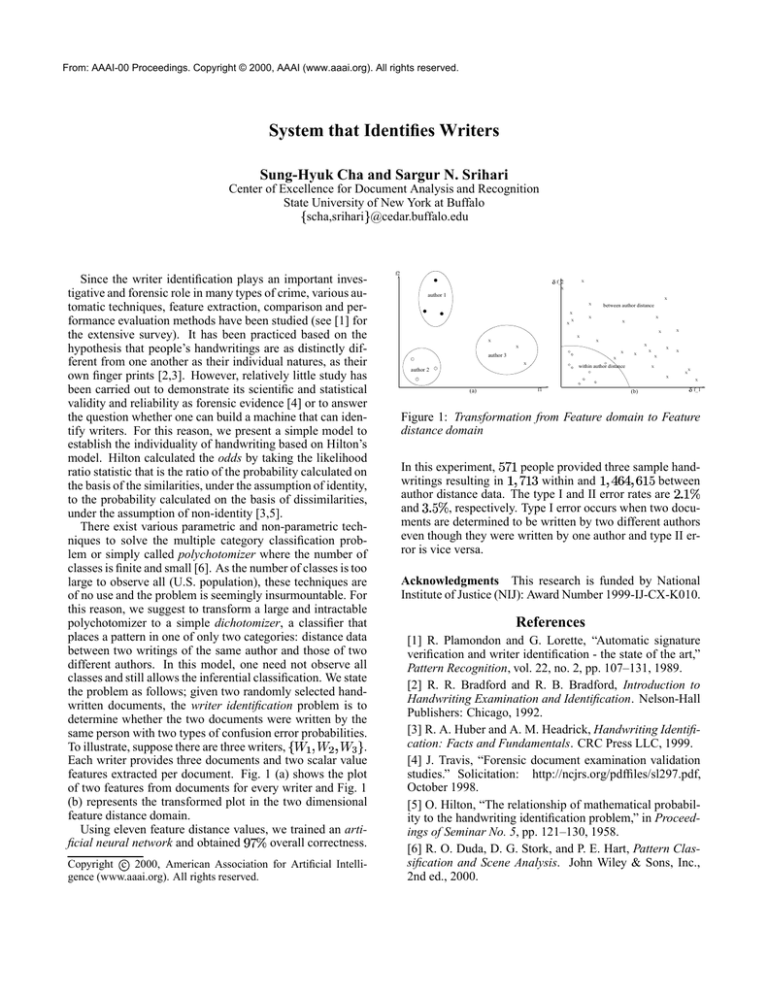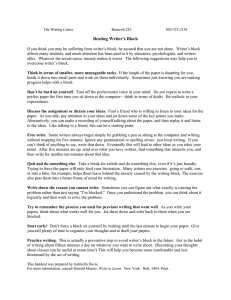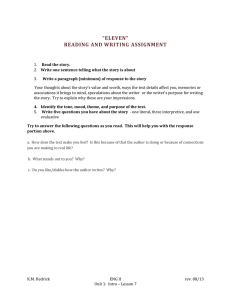
From: AAAI-00 Proceedings. Copyright © 2000, AAAI (www.aaai.org). All rights reserved.
System that Identifies Writers
Sung-Hyuk Cha and Sargur N. Srihari
Center of Excellence for Document Analysis and Recognition
State University of New York at Buffalo
scha,srihari @cedar.buffalo.edu
Since the writer identification plays an important investigative and forensic role in many types of crime, various automatic techniques, feature extraction, comparison and performance evaluation methods have been studied (see [1] for
the extensive survey). It has been practiced based on the
hypothesis that people’s handwritings are as distinctly different from one another as their individual natures, as their
own finger prints [2,3]. However, relatively little study has
been carried out to demonstrate its scientific and statistical
validity and reliability as forensic evidence [4] or to answer
the question whether one can build a machine that can identify writers. For this reason, we present a simple model to
establish the individuality of handwriting based on Hilton’s
model. Hilton calculated the odds by taking the likelihood
ratio statistic that is the ratio of the probability calculated on
the basis of the similarities, under the assumption of identity,
to the probability calculated on the basis of dissimilarities,
under the assumption of non-identity [3,5].
There exist various parametric and non-parametric techniques to solve the multiple category classification problem or simply called polychotomizer where the number of
classes is finite and small [6]. As the number of classes is too
large to observe all (U.S. population), these techniques are
of no use and the problem is seemingly insurmountable. For
this reason, we suggest to transform a large and intractable
polychotomizer to a simple dichotomizer, a classifier that
places a pattern in one of only two categories: distance data
between two writings of the same author and those of two
different authors. In this model, one need not observe all
classes and still allows the inferential classification. We state
the problem as follows; given two randomly selected handwritten documents, the writer identification problem is to
determine whether the two documents were written by the
same person with two types of confusion error probabilities.
To illustrate, suppose there are three writers,
.
Each writer provides three documents and two scalar value
features extracted per document. Fig. 1 (a) shows the plot
of two features from documents for every writer and Fig. 1
(b) represents the transformed plot in the two dimensional
feature distance domain.
Using eleven feature distance values, we trained an artificial neural network and obtained
overall correctness.
Copyright c 2000, American Association for Artificial Intelligence (www.aaai.org). All rights reserved.
f2
X
f_2
X
author 1
X
X
between author distance
X
X
X
X
X
X
X
X
X
X
X
X
X
X
author 3
X
X
X
within author distance
author 2
X
X
X
X
X
X
X
(a)
f1
(b)
X
X
f_1
Figure 1: Transformation from Feature domain to Feature
distance domain
In this experiment,
people provided three sample handwritings resulting in
within and
between
author distance data. The type I and II error rates are
and
, respectively. Type I error occurs when two documents are determined to be written by two different authors
even though they were written by one author and type II error is vice versa.
Acknowledgments This research is funded by National
Institute of Justice (NIJ): Award Number 1999-IJ-CX-K010.
References
[1] R. Plamondon and G. Lorette, “Automatic signature
verification and writer identification - the state of the art,”
Pattern Recognition, vol. 22, no. 2, pp. 107–131, 1989.
[2] R. R. Bradford and R. B. Bradford, Introduction to
Handwriting Examination and Identification. Nelson-Hall
Publishers: Chicago, 1992.
[3] R. A. Huber and A. M. Headrick, Handwriting Identification: Facts and Fundamentals. CRC Press LLC, 1999.
[4] J. Travis, “Forensic document examination validation
studies.” Solicitation: http://ncjrs.org/pdffiles/sl297.pdf,
October 1998.
[5] O. Hilton, “The relationship of mathematical probability to the handwriting identification problem,” in Proceedings of Seminar No. 5, pp. 121–130, 1958.
[6] R. O. Duda, D. G. Stork, and P. E. Hart, Pattern Classification and Scene Analysis. John Wiley & Sons, Inc.,
2nd ed., 2000.




